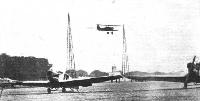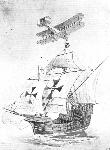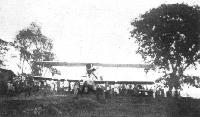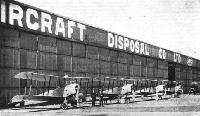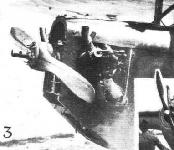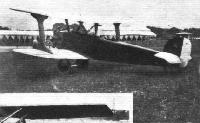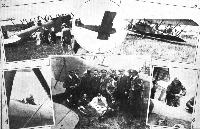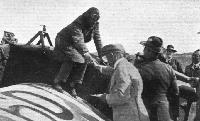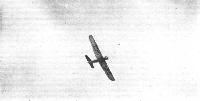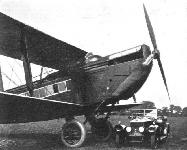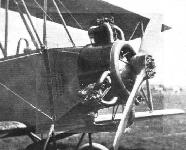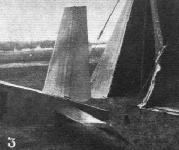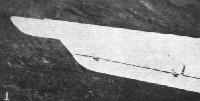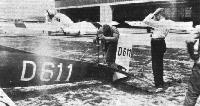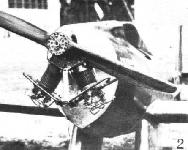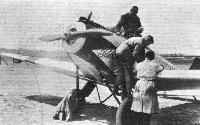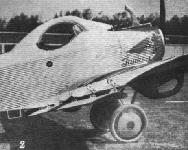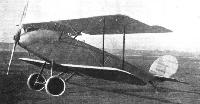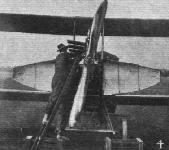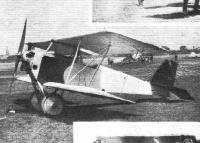Фотографии
-
FAIREY SEAPLANES FOR HOLLAND: As previously reported in "Flight," the Fairey Aviation Co., Ltd., of Hayes, recently delivered to the Dutch Government a batch of Series III seaplanes (Napier "Lion" engines). The above photograph shows the machines anchored at Hamble, from which place they were flown to Holland by Dutch pilots.
Самолёты на фотографии: Fairey Fairey III - Великобритания - 1917
-
Регистрационный номер: D-690 OLD-TIMER: The Albatros L.30. Machine is fitted with 100 h.p. Mercedes engine and is of 1914 design.
Самолёты на фотографии: Albatros B.I/B.II/B.III - Германия - 1913
-
A Heinkel biplane coming in after a test flight. The machines in the foreground are Junkers commercial monoplanes.
Самолёты на фотографии: Heinkel HD.21/22/24/32/35/36 - Германия - 1924Junkers F 13 - Германия - 1919
-
TWO ATLANTIC CROSSINGS: Six years ago, on Sunday next, a Vickers' "Vimy" with two Rolls-Royce engines, piloted by the late Sir John Alcock, and navigated by Sir A. Whitten Brown, left Newfoundland on its flight across the Atlantic, landing 16 hours 12 mins. later at Clifden, Co. Galway, Ireland, thus completing the first non-stop flight across the Atlantic. Columbus's ship "Santa Maria," left the Canary Islands on September 6, 1492, and made a landfall at what is now known as Watling Island, in the Bahama group, on October 12. The object of the above illustration is to show the comparative sizes of the craft, and it might be pointed out that the drawing was made over a photograph of two models made to the same scale and photographed in position in the vertical plane, so that even taking into account the effect of perspective a correct idea of relative sizes is obtained.
Самолёты на фотографии: Vickers Vimy / FB.27 - Великобритания - 1917
-
The ltalian Rome-Australia Flight: Col. M.di Pinedo's Savoia S.16 ter flying boat (400 h.p. Lorraine-Dietrich) at the Air Survey Co.'s slipway at Rangoon (May 14 last).
Самолёты на фотографии: SIAI S.16 / S.53 - Италия - 1919
-
SOME OF THE ENGINES IN THE ROUND-GERMANY COMPETITION. The nose of the Focke-Wulf fitted with the six-cylinder air-cooled Junkers engine.
Самолёты на фотографии: Focke-Wulf A.16 - Германия - 1924
-
Avros for Spain: A batch of Avro 504K machines ready for delivery to the Spanish Royal Naval Air Service. They are being supplied by the Aircraft Disposal Co., Ltd., and Capt. Cortijo, of the Spanish Royal Naval Commission, and Maj. J. Stewart, sales manager of the "A.D.C.," will be seen standing by the machines.
Самолёты на фотографии: Avro Avro 504 - Великобритания - 1913
-
Регистрационный номер: G-EBKT LONDON-ZURICH AND BACK IN A DAY: The De Havilland "Moth" (D.H. 60) light 'plane, fitted with a 60 h p "Cirrus" engine, on which Alan Cobham flew from London to Zurich and back in a day. The "Cirrus," which is manufactured by the Aircraft Disposal Co., is a 4-cyl. "in line" (vertical) air-cooled engine.
Самолёты на фотографии: De Havilland Moth / D.H.60 - Великобритания - 1925
-
Регистрационный номер: M-MWAE SAFE! The good news of Amundsen's safe return, with all his party, from the Arctic regions was received last week. Above we show the Dornier-Wal mono, flying boat, fitted with two Rolls-Royce "Eagles," which was the type of machine in which Amundsen made his gallant attempt to reach the North Pole.
Самолёты на фотографии: Dornier Do.J Wal - Германия - 1922
-
SOME OF THE ENGINES IN THE ROUND-GERMANY COMPETITION. The A.B.C. "Scorpion," in the Udet "Kolibri."
Самолёты на фотографии: Udet U-7 Kolibri - Германия - 1924
-
The Udet U.12 is the first biplane to be built by this firm. The inter 'plane struts are of Duralumin
Самолёты на фотографии: Udet U-12 Flamingo - Германия - 1925
-
SOME RUNDFLUG MACHINES: A three-quarter rear view of the Udet biplane "Flamingo," piloted by Herr Udet himself
Самолёты на фотографии: Udet U-12 Flamingo - Германия - 1925
-
Регистрационный номер: D-651 The Albatros L.68 is a small single-seater biplane with 75 h.p. Siemens engine. In the competition it is piloted by Freiherr v. Richthofen, brother of the famous German air fighter
Самолёты на фотографии: Albatros L.68 Alauda - Германия - 1925
-
WITH THE R.A.F. IN IRAQ: We show above one of the Vickers "Victoria" aerial transports (two 450 h.p. Napier "Lion" engines) at Hinaidi aerodrome. These machines, which can carry 25 soldiers complete with equipment, in addition to the crew of two, have done excellent work, not only in transporting troops, but in conveying sick and wounded from one part of the country to another in a matter of hours as against days by other means of transport.
Самолёты на фотографии: Vickers Victoria - Великобритания - 1922
-
AT THE R.A.F. DISPLAY: The Blackburn "Cubaroo" Torpedo Carrier (1,000 h.p. Napier "Cub").
Самолёты на фотографии: Blackburn Cubaroo / T.4 - Великобритания - 1924
-
Регистрационный номер: J6997 AT THE R.A.F. DISPLAY: The Bristol "Brandon" Ambulance (400 h.p. Bristol "Jupiter").
Самолёты на фотографии: Bristol Ten-Seater / Brandon - Великобритания - 1921
-
AT THE R.A.F. DISPLAY: The Short "Springbok" Army Co-operation (400 h.p. Bristol "Jupiter").
Самолёты на фотографии: Short Springbok / Chamois / S.3 - Великобритания - 1923
-
THE ITALIAN VISIT TO CROYDON: 1. One of the machines arriving at Croydon. 2. The pilot and crew of one of the four machines being greeted by their Italian compatriots (complete with flag) on landing. 3. The Fiat B.R.I long-distance day bomber, 700 h.p. Fiat engine. 4. The pilot of No.1 machine, Capt. Ferrarin. 5. A group of some of the Italian airmen, R.A.F. officers and friends. Included in the group are Capts. Brack-Papa, Ferrarin, and Major S. Scaroni (without hat), Italian Air Attache. 6. Capt. Brack-Papa.
Самолёты на фотографии: FIAT BR - Италия - 1919
-
Регистрационный номер: J7504 Типичный гоночный гидросамолет своего времени, Gloster II представлял собой попытку разместить двигатель максимальной мощности в планере минимальных размеров. Другими характеристиками, например, хорошей управляемостью, приходилось жертвовать.
The Gloster II Seaplane: It was on a sister 'plane fitted with wheels that Larry Carter met with a mishap while flying at Cranwell. The engine is a Napier "Lion." Note the careful streamlining and the Lamblin strut radiators.Самолёты на фотографии: Gloster I - III - Великобритания - 1923
-
Регистрационный номер: J6989 The Hawker "Heron," a single-seater Fighter of metal construction, fitted with a 400 h.p. Bristol "Jupiter," which will be seen at the R.A.F. Display at Hendon on Saturday.
Самолёты на фотографии: Hawker Heron / Hornbill / Hawfinch / Hoopoe - Великобритания - 1925
-
ROUND-GERMANY COMPETITION: The Heinkel H.D.32 biplane, fitted with Bristol "Lucifer'' engine, covered the total distance of 5,242 kms.
Самолёты на фотографии: Heinkel HD.21/22/24/32/35/36 - Германия - 1924
-
SOME RUNDFLUG MACHINES: The Stahlwerk parasol monoplane.
Самолёты на фотографии: Rieseler R.III / R.IV - Германия - 1922
-
Round-Germany Competition: Winner of first prize in Class B, Herr Hochmuth, descending from his Udet U.10 monoplane with Siemens engine.
Самолёты на фотографии: Udet U-6 / U-10 - Германия - 1923
-
Регистрационный номер: D-640 FIRST MAN HOME The Udet U.10, piloted by Billik, was the first to cross the finishing line after covering the first circuit
Самолёты на фотографии: Udet U-6 / U-10 - Германия - 1923
-
Регистрационный номер: J6910 AN EXPERIMENTAL MACHINE AT THE R.A.F. DISPLAY: The Boulton and Paul "Bodmin" (two 400 h.p. Napier "Lions") with gear transmission.
Самолёты на фотографии: Boulton Paul Bodmin / P.12 - Великобритания - 1922
-
SOME RUNDFLUG MACHINES: 1 is a Dietrich monoplane, with Siemens engine
Самолёты на фотографии: Dietrich DP.VII / DP.VIIa - Германия - 1924
-
Регистрационный номер: D-652, D-684 ON THE STARTING LINE In the foreground the Albatros L.69 with Bristol "Lucifer" engine, and behind it a Dietrich biplane.
Самолёты на фотографии: Albatros L.69 - Германия - 1925Dietrich DP.II - Германия - 1923
-
SOME OF THE ENGINES IN THE ROUND-GERMANY COMPETITION. 6 and 7 show Siemens engines as mounted in Dietrich biplanes, No. 6 being of the latest type.
Самолёты на фотографии: Dietrich DP.II - Германия - 1923
-
A NON-STARTER IN THE RUNDFLUG: The Messerschmitt M.17 light monoplane, with A.B.C. "Scorpion" engine, which crashed owing to coming into contact with some overhead electric high-tension cables.
Самолёты на фотографии: Messerschmitt S15 / S16 / M.17 - Германия - 1923
-
Регистрационный номер: G-EBKI [2] The D.H.54 is a very large single-engined machine, and in this photograph the Rolls-Royce car standing under the nose gives an excellent idea of the relative size.
Самолёты на фотографии: De Havilland Highclere / D.H.54 - Великобритания - 1925
-
Регистрационный номер: G-EBKI [2] The D.H.54 with Rolls-Royce "Condor" engine has seating accommodation for 14 passengers.
Самолёты на фотографии: De Havilland Highclere / D.H.54 - Великобритания - 1925
-
SOME CONSTRUCTIONAL DETAILS OF THE D.H.54: 1, The rear chassis strut is attached to the lower longeron by a fork-end and pin; when the pin is withdrawn, by means of the crank and rod shown, the leg is free to drop; 2 shows details of the hook attachment of axle to front chassis strut; while 3 and 4 are diagrammatic representations of the manner in which the undercarriage drops. The front struts remain on the machine, but swing free. 5 gives details of the rib construction, and 6 shows a spar root, with strut attachment and wiring lugs.
Самолёты на фотографии: De Havilland Highclere / D.H.54 - Великобритания - 1925
-
D.H.54 Commercial Machine Rolls-Royce "Condor" Engine
Самолёты на фотографии: De Havilland Highclere / D.H.54 - Великобритания - 1925
-
The Caspar C.26 has an exaggerated gap and a very peculiar tail. The engine is a Bristol "Lucifer."
Самолёты на фотографии: Caspar C.26 - Германия - 1925
-
SOME OF THE ENGINES IN THE ROUND-GERMANY COMPETITION. The Bristol "Lucifer," in the Caspar C.26.
Самолёты на фотографии: Caspar C.26 - Германия - 1925
-
IN THE ROUND-GERMANY FLIGHT: The unusual fin and rudder of the Caspar C.26
Самолёты на фотографии: Caspar C.26 - Германия - 1925
-
IN THE ROUND-GERMANY FLIGHT: The combined trailing edge and wing-tip flap on the single-engined Mercedes-Daimler L.20.
Самолёты на фотографии: Daimler L 20 - Германия - 1924
-
SOME OF THE ENGINES IN THE ROUND-GERMANY COMPETITION. The Mercedes Daimler in the L.20. Note the steel tube mounting.
Самолёты на фотографии: Daimler L 20 - Германия - 1924
-
Регистрационный номер: D-611 [3] THE SMALLEST MACHINE IN THE COMPETITION: The Darmstadt "Mohamed," fitted with Blackburne "Tomtit" engine, has to its credit a distance of 1,320 kms. It was designed and built by the Darmstadt students
Самолёты на фотографии: Darmstadt D-11 Mohamed - Германия - 1924
-
Регистрационный номер: D-611 [3] Boxing the compass: An official taking a bearing for checking the compass of the Darmstadt "Mohamed."
Самолёты на фотографии: Darmstadt D-11 Mohamed - Германия - 1924
-
Регистрационный номер: D-611 [3] SOME OF THE ENGINES IN THE ROUND-GERMANY COMPETITION. The Blackburn "Tomtit," in the Darmstadt "Mohamed."
Самолёты на фотографии: Darmstadt D-11 Mohamed - Германия - 1924
-
Getting ready for engine tests: A metal sheathed calibrated propeller is used for ascertaining the power at full throttle. This photograph shows the Junkers T.29 being prepared.
Самолёты на фотографии: Junkers T 29 - Германия - 1925
-
The Junkers T.29 is of recent design, and is fitted with very unusual ailerons
Самолёты на фотографии: Junkers T 29 - Германия - 1925
-
IN THE ROUND-GERMANY FLIGHT: The unusual aileron on one of the Junkers T.29's. This aileron depends upon the "tandem aerofoil" effect for its greater lift. Easy adjustments are provided for varying the size of slot.
Самолёты на фотографии: Junkers T 29 - Германия - 1925
-
OLD-TIMER: The L.F.G., V.39, fitted with 100 h.p. Mercedes engine and is of 1914 design.
Самолёты на фотографии: LFG V.39 - Германия - 1925
-
Регистрационный номер: D-679 OFF! The Albatros L.69 with Siemens engine gets away
Самолёты на фотографии: Albatros L.69 - Германия - 1925
-
THE ALBATROS L.69, with Bristol "Lucifer" engine, was not tuned up in time to take part in the competition. This machine is credited with a speed of 220 kms./ph. (135 m.p.h.).
Самолёты на фотографии: Albatros L.69 - Германия - 1925
-
The Caspar "Kobes" was designed by Herr Karl Theis, who has now joined the firm as chief designer. Herr Theis was formerly chief designer of the Halberstadt Works
Самолёты на фотографии: Caspar C.24 / Caspar-Theiss CT.2 - Германия - 1925
-
Регистрационный номер: D-673 AWAY ON THE FIRST CIRCUIT: The Caspar "Kobes" starts
Самолёты на фотографии: Caspar C.24 / Caspar-Theiss CT.2 - Германия - 1925
-
IN THE ROUND-GERMANY FLIGHT: The hinged engine cowl on the C.24, which gives unobstructed access to every part of the engine.
Самолёты на фотографии: Caspar C.24 / Caspar-Theiss CT.2 - Германия - 1925
-
The Baumer monoplane with Wright engine is probably the fastest in Class B, and is being piloted by Herr Baumer himself
Самолёты на фотографии: Baumer B.II Sausewind - Германия - 1925
-
Регистрационный номер: D-638 The Baumer biplane is of a red colour which nearly defeated our photographer. The engine is a Wright three-cylinder, air cooled
Самолёты на фотографии: Baumer B.III Alsterkind - Германия - 1925
-
A TWIN-ENGINED LIGHT 'PLANE: The Mercedes Daimler L.21, built as a parasol monoplane with two Mercedes Daimler engines built into the leading edge of the wing. On the left is shown one of the 19-h.p. engines, while on ,the right is a front view of the central portion, which gives a good idea of the strut bracing arrangement.
Самолёты на фотографии: Daimler L 21 - Германия - 1925
-
Регистрационный номер: D-623 WINNER OF FIRST PRIZE IN LIGHT 'PLANE CLASS: The Mercedes Daimler L.21, piloted by Herr Loerzer, has won first prize in Class A, being credited with a total distance of 3,219 kms. The machine is fitted with two Mercedes 19 h.p. engines. The two L.21 machines are the only twin-engined aeroplanes in the competition
Самолёты на фотографии: Daimler L 21 - Германия - 1925
-
The Lubeck monoplane is the work of members of the Lubeck Aeronautical Society. The engine is a Siemens
Самолёты на фотографии: Lubeck (Flugtechnische Verein Lubeck) monoplane - Германия - 1925
-
SOME RUNDFLUG MACHINES: A Stahlwerk biplane.
Самолёты на фотографии: Stahlwerk-Mark MS.2 - Германия - 1925
-
Регистрационный номер: N187 AT THE R.A.F. DISPLAY: The Hawker "Hedgehog" three-seater Reconnaissance (400 h.p. Bristol "Jupiter.")
Самолёты на фотографии: Hawker Hedgehog - Великобритания - 1924
Статьи
- Flight


